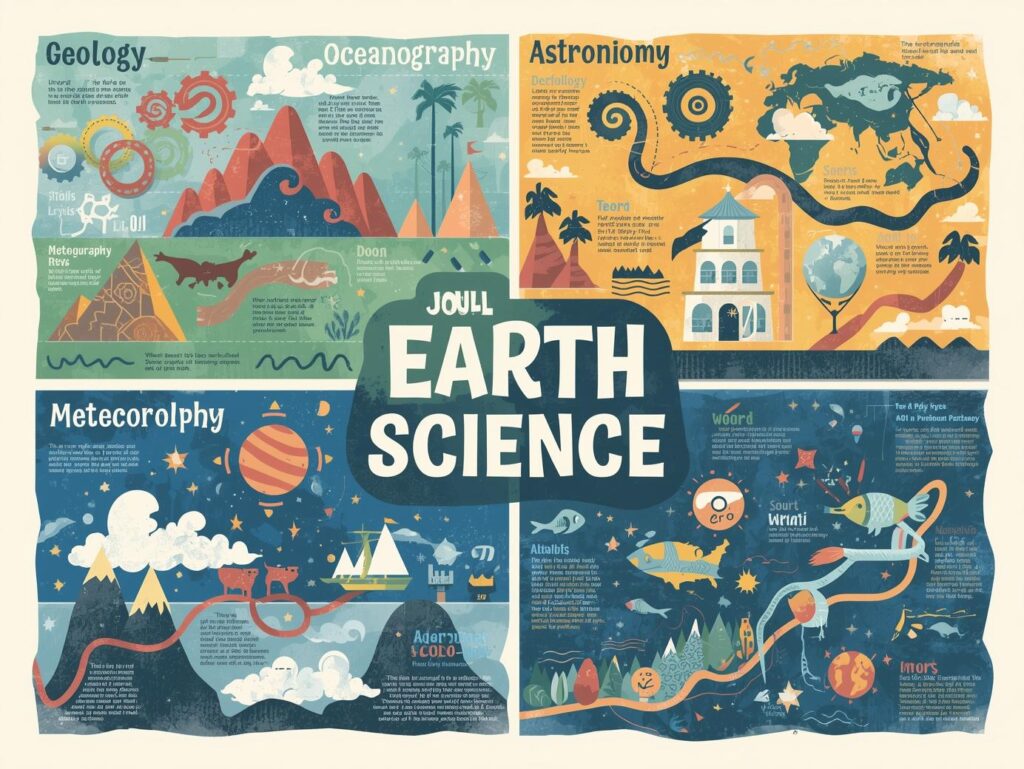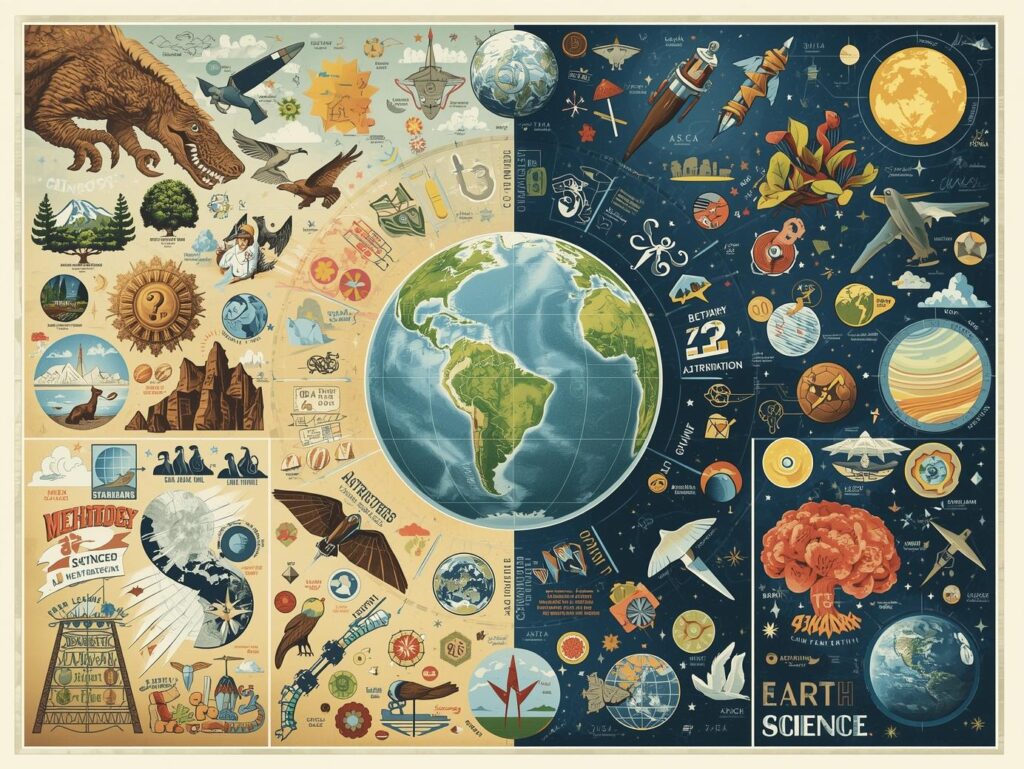Ever curious what makes our world tick? From the shaking of earthquakes to the drift of clouds in the air, the branches of Earth science enable us to piece together Earth’s history. Imagine a gigantic machine with its components linked; each component, or branch, tells us something different about how our world works. These disciplines are all united under Earth system science, an approach to studying the planet as one gigantic, dynamic system.
Branches of earth science
The Big Picture: Earth System Science
Earth systems science considers the entire planet as a unified system, similar to a living being with interconnected systems. Consider Earth as a spaceship; its atmosphere, oceans, land, and life work in harmony to keep it functioning. This strategy, commonly referred to as earth and environmental science, aims not at an individual component but at how everything is interdependent. For instance, a volcano doesn’t merely erupt lava, it also emits gases that impact the atmosphere, which, in turn, alters weather patterns and influences oceans and forests. Through these connections, we have a better sense of our planet’s health.
All the branches of earth science work toward this broad perspective. From rocks on the ground to the stars in the sky, these disciplines inform us about Earth’s past, present, and future. Let’s dissect the primary branches: geology, oceanography, meteorology, hydrology, and astronomy. Ready? Let’s start.
Geology: The Story of Earth’s Bones
Geology is all about the solid stuff—Earth’s rocks, minerals, and forces that create them. It’s like reading the planet’s diary, where each layer of rock has a story of old rivers, volcanoes, or shifting continents. Geologists excavate mountains to learn about how they were created millions of years ago. The Himalayas, for example, was formed when tectonic plates bumped into each other, and geologists analyze those plates to foretell earthquakes today.
This division also encompasses soil and fossils. Discovering a dinosaur bone is not only cool—it tells us about life long ago. Geology in earth environmental science assists us in finding resources such as oil or metals, but also shows us how to do it without hurting the earth. It’s also handy; knowing where the fault lines are can save lives by informing safe construction practices.

Oceanography: Venturing into the Blue Heart
The oceans blanket over 70% of the globe, making oceanography a significant discipline. Oceanography examines everything from pounding surf to animals deep within the ocean. Imagine yourself on a ship following currents that transport heat water around the planet, or scuba diving on a coral reef teeming with fish. Oceanographers make such work, yet also observe salinity, chart the sea floor, and research the ways plastic pollution kills sea life.
An interesting case in point is the Great Barrier Reef. Oceanographers track its health, observing how warming oceans impact coral. This relates to earth systems science because oceans control climate by storing heat and carbon dioxide. They influence weather too, such as hurricanes that develop over warm oceans. Studying these patterns helps us preserve coastal communities and sea life.
Meteorology: Decoding the Sky
Ever checked a weather app before going out? That’s meteorology at work, one of the key branches of earth science. It’s the study of the atmosphere—why it rains, how storms form, and what causes a sunny day to turn windy. Meteorologists don’t just predict tomorrow’s weather; they analyze long-term climate trends. For example, they use satellite data to track how greenhouse gases trap heat and contribute to global warming.
Imagine the atmosphere as the Earth’s blanket, never static. A monsoon in India or a tornado in Oklahoma demonstrates its fury. Meteorology is interlinked with other areas of earth and environmental science, like how hurricane storms are fueled by ocean temperatures or how volcanic ash passesively cools the planet for a time. It’s about protecting us and being ready, be it for a heatwave or a snowstorm.
Hydrology: Tracing the Path of Water
Water is vital, and hydrology is the field that examines it. This area of earth environmental science considers water in rivers, lakes, glaciers, and even under the ground. Visualize a river cutting through a valley; it’s not only scenic; it carves up the terrain and transports nutrients to environments. Hydrologists determine where the water goes, how much there is, and how to maintain it clean.

For instance, hydrologists in California track aquifers to prevent depletion in times of drought. Hydrologists also research melting ice in the Arctic that puts extra water into the global sea. Hydrology bridges to earth systems science by demonstrating how water is the connecting thread among land, air, and life. Without it, we would not be able to prevent flooding or safeguard drinking water supplies.
Astronomy: Earth’s Place in the Cosmos
What is earth and space science? It’s where astronomy fits in, zooming out to observe Earth as part of the universe. This area delves into how our world finds its place within the solar system and beyond. The moon’s gravitational pull affects our tides, the sun’s rays determine our climate, and cosmic phenomena, such as meteor impact, have formed Earth’s history. Recall that asteroid that killed off the dinosaurs? That’s astronomy in action.
Astronomers employ telescopes to examine distant worlds, which tells us what makes Earth unique. As an example, Mars’ barren surface reveals what occurs without a robust atmosphere. This branch relates to earth system science by unveiling how the cosmos impacts our world, ranging from solar flares inducing auroras to the gradual tilt of Earth’s axis altering seasons.
Why These Branches Matter Together
All the branches of earth science have their own tale, but combined, they create a full picture. Earth systems science integrates them, illustrating how a shift in one branch, such as melting ice, impacts the others, increasing sea levels and altering weather. That is why earth and environmental science is crucial. It enables us to deal with big issues such as climate change, where rising oceans impact storms, which further impact rivers and forests.
Real-world applications highlight this collaboration. When a tsunami hits, oceanographers monitor its waves, geologists analyze the earthquake that triggered it, and meteorologists forecast its impact area. Hydrologists evaluate flood hazards. They save lives and reconstruct communities together. Or look at mining: geologists find minerals, hydrologists provide clean water, and environmental scientists track environmental impacts.
Daily Examples of Earth Science in Action
These branches of science aren’t exclusive to labs—daily life is filled with them. Geology assists in constructing stable bridges through soil strength testing. Oceanography informs fishermen of bad seas. Meteorology keeps airplanes secure by predicting turbulence. Hydrology makes your tap water safe. And astronomy? It enables GPS, guiding you through your road trips.
Think about a beach vacation. The sand (geology) was shaped by waves (oceanography), under a sky tracked by meteorologists. The water’s purity (hydrology) and the tides (astronomy) make it safe to swim. That’s earth systems science in action, making your day possible.
The Future of These Fields
These earth sciences are evolving with technology. Drones chart distant glaciers, artificial intelligence forecasts weather patterns, and rovers dig on Mars to compare with Earth. For students or the merely curious, these disciplines open endless doors—become a geologist hunting for fossils, an oceanographer preserving reefs, or an astronomer uncovering new worlds.
Earth science is not about facts; it’s about wonder. The next time you look at a river glint or a star shine, consider the systems in place. They’re all pieces of our planet’s history, and these fields allow us to comprehend it, preserve it, and impart it.
